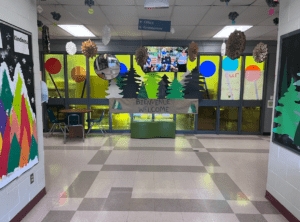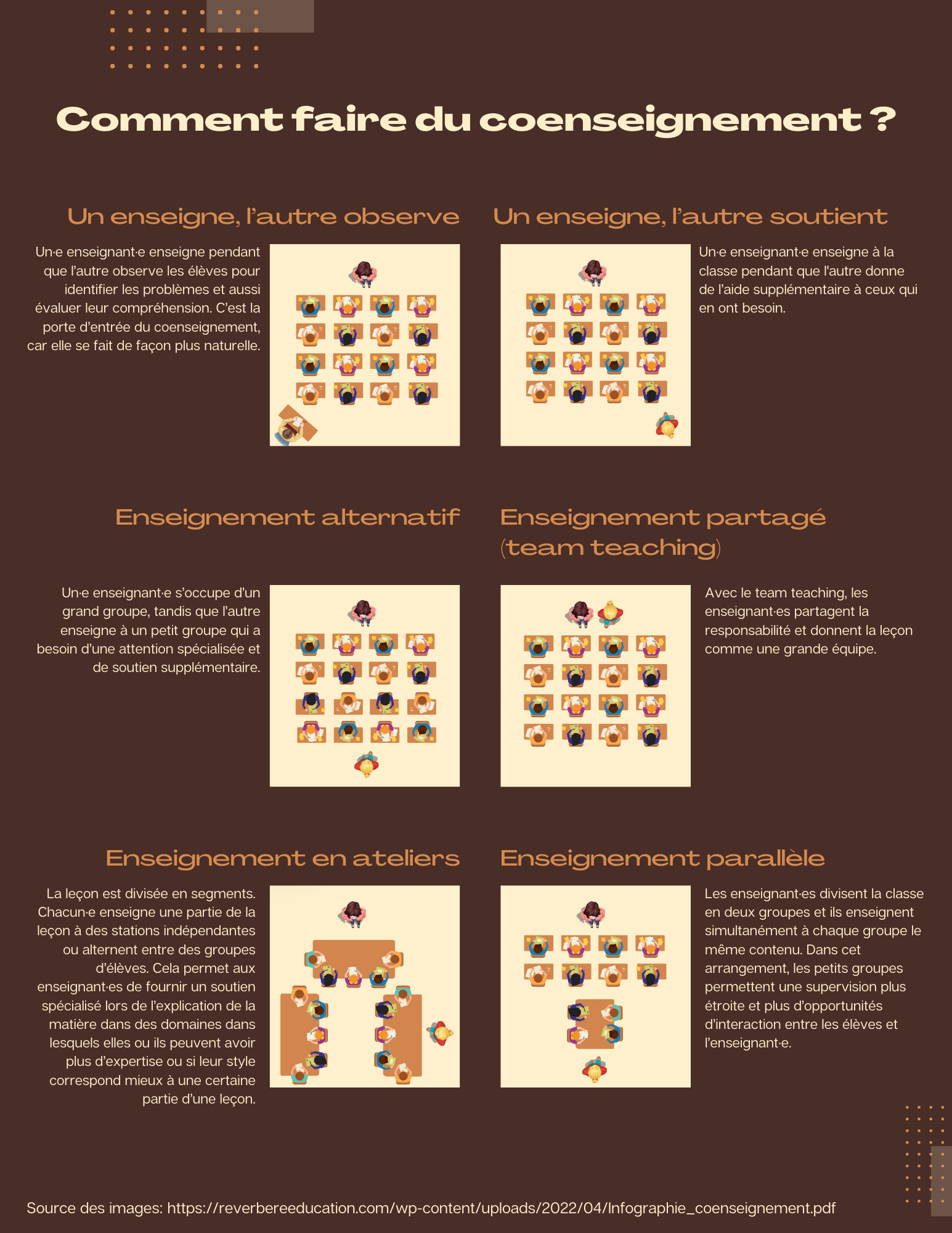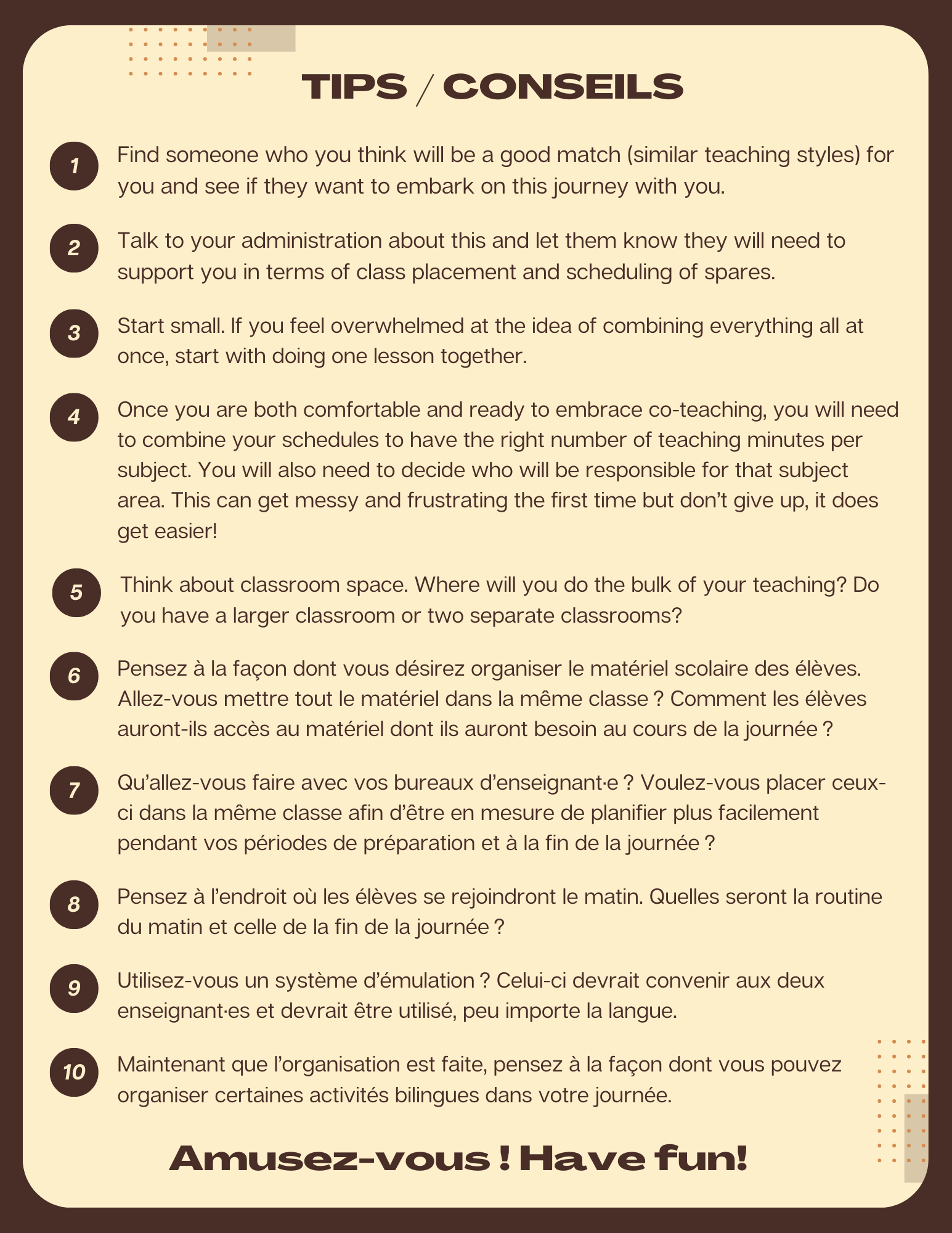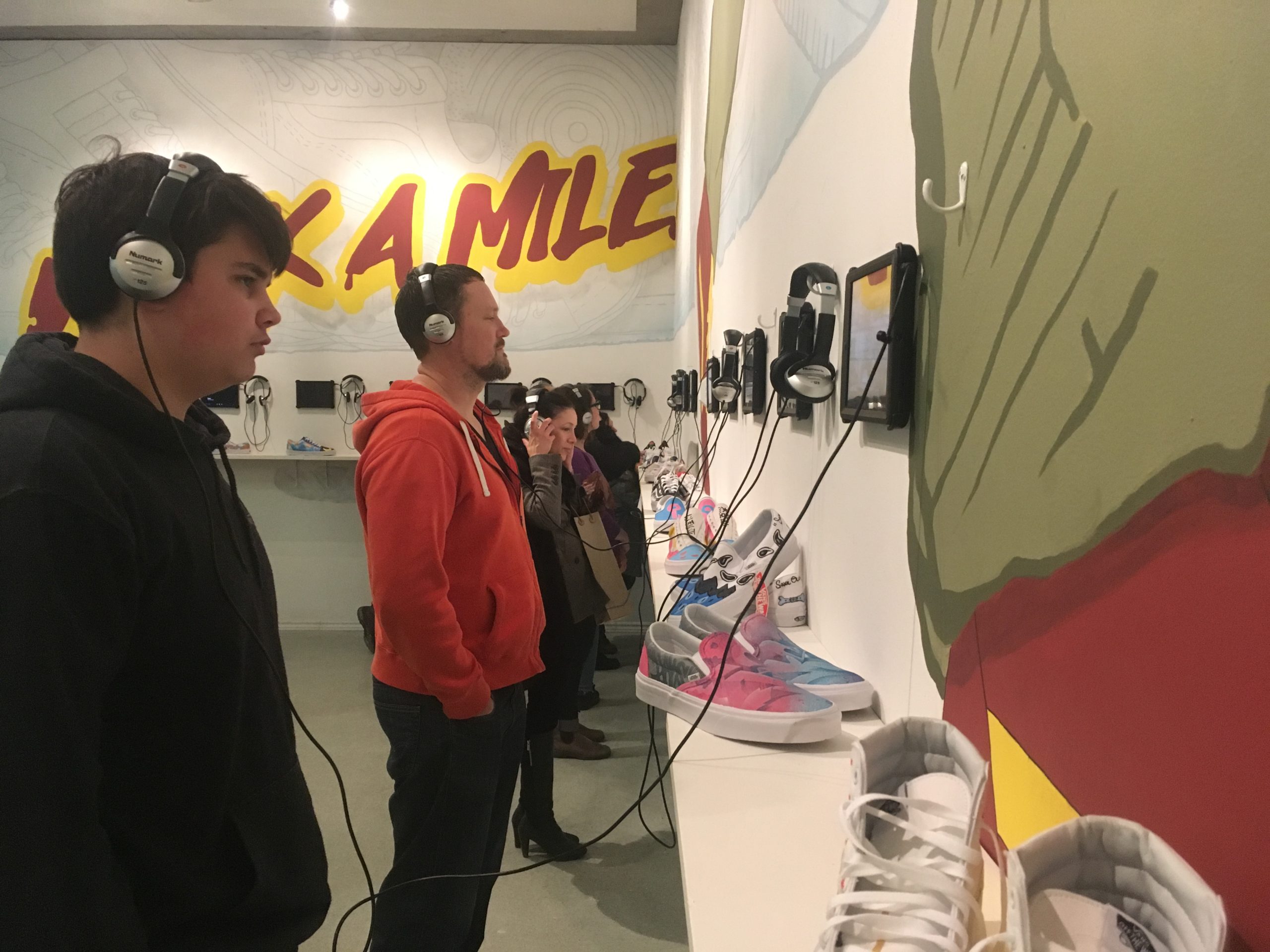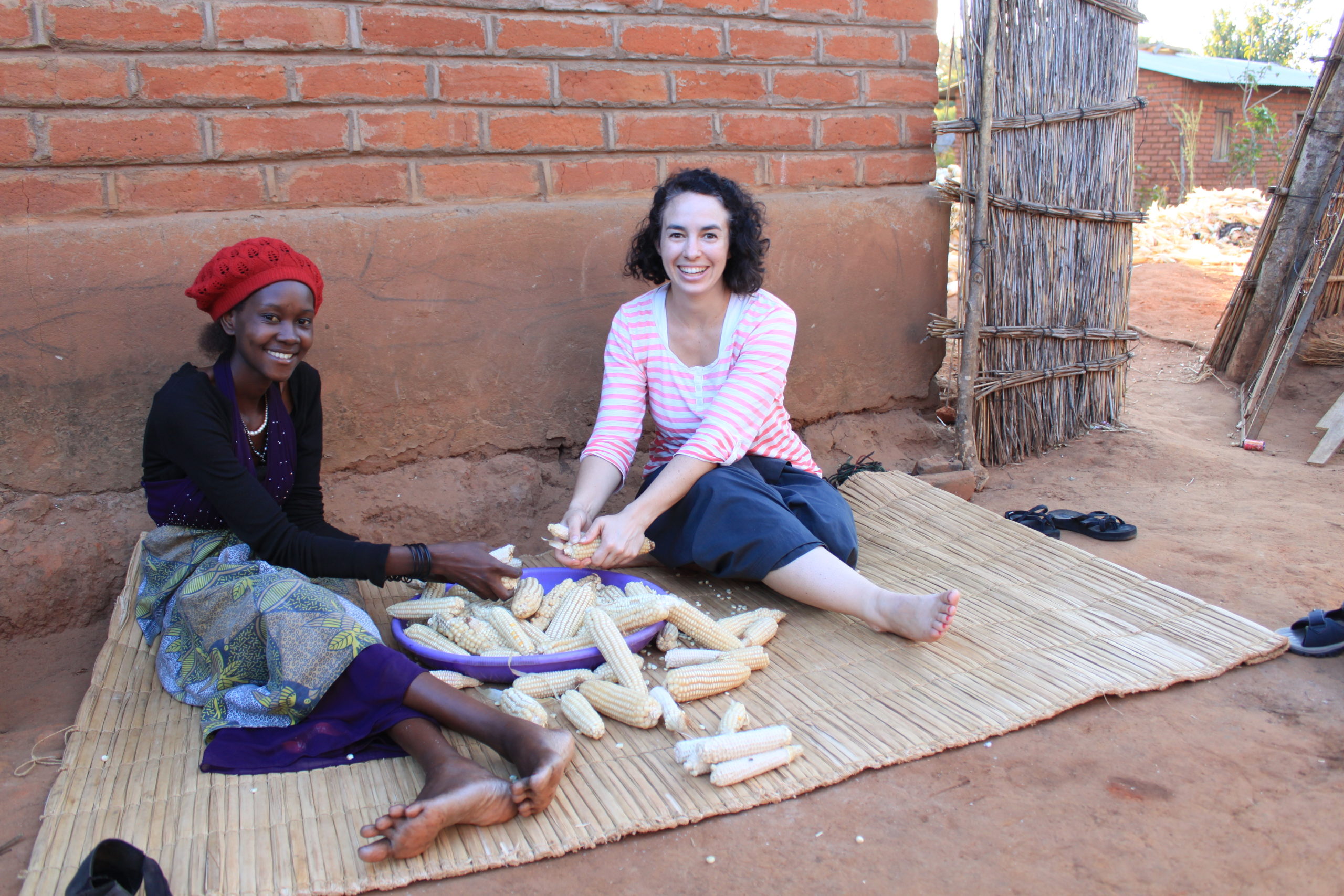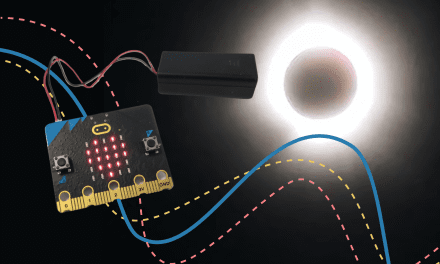Collaboration de Julie Paré, Marisa Furino et Marie-Eve Frenette
Marisa Furino et Marie-Eve Frenette font du coenseignement depuis 2019 à l’école primaire Evergreen de Saint-Lazare de la Commission scolaire Lester-B.-Pearson. Leur engouement pour cette stratégie pédagogique est contagieux ! Je les ai rencontrées pour en apprendre davantage sur leur histoire. Voici un article qui présente ces deux enseignantes passionnées de coenseignement.
Note : Le texte qui suit est bilingue tout comme le coenseignement de Marisa Furino et Marie-Eve Frenette.
 MARISA FURINO
MARISA FURINO
I am a mother of three children; a 15 year old boy, a 13 year old girl, and a 10 year old boy. I am of Italian descent and love family gatherings. I am also a teacher that has been teaching at the elementary level for about 20 years. When I think of my life surrounded by all these kids, I can say that I have experienced the gamut of emotions. It has been full, busy, chaotic, fun, thrilling, frustrating, sad, draining, and inspiring to name a few. I am a lover of life. I enjoy the rollercoaster because that means I am living my life to the fullest. I love to read, cook, travel and learn new things. I think of myself as a creative type.
 MARIE-EVE FRENETTE
MARIE-EVE FRENETTE
Je suis la maman de deux garçons, dont un ado de 15 ans et un préado de 12 ans. J’ai maintenant aussi un petit chiot de 7 mois qui demande beaucoup d’attention. Ma vie familiale est donc très occupée entre les entraînements de hockey, les devoirs et l’élevage d’un chien. J’enseigne maintenant depuis près de 20 ans à la Commission scolaire Lester-B.-Pearson en français langue seconde, malgré le fait que ma formation initiale soit en enseignement préscolaire et primaire.
EVERGREEN ELEMENTARY SCHOOL, LBPSB
Both Marie-Eve and I teach at Evergreen Elementary, a school in the wooded area of Saddlebrook in St Lazare. Our school offers a 50/50 bilingual program where children learn both official languages. The majority of students are anglophone but in recent years we have had a few more francophone families join our school community. Our school is vibrant and has a dedicated and caring staff that is committed to academic achievement, bilingualism, computer literacy, and a sense of community responsibility.
Notre classe se compose de 39 élèves dont la majorité a l’anglais comme langue maternelle. De ces 39 élèves, nous avons 19 plans d’intervention qui comprennent 4 élèves qui ont un trouble du spectre de l’autisme, 5 qui ont de gros problèmes d’apprentissage (LD), 2 qui ont un très grand niveau d’anxiété et 2 qui ont de gros problèmes de comportement. Il y a aussi de nombreux autres élèves qui ont des difficultés qui ne sont pas encore évaluées.
OUR STORY
 The idea of co-teaching came at a time in my life when I thought that I would no longer be able to teach. I had been teaching primarily in grade 4 for about 10 years and every year it got harder and harder to be the teacher I wanted to be. There were just too many kids with needs and with sad life stories that I couldn’t possibly help. I knew I was a good teacher but I no longer felt like one. I got to a point when I burnt out. For those of you who have been there, you sometimes do not realize that you’re on the path of burning out before it is too late. This began one of the darkest periods of my life. I experienced debilitating anxiety and subsequent depression and thought that teaching was no longer something I could do. When I tried to think of something else I wanted to do, I couldn’t see myself do anything else but teach!! I loved teaching but it was literally making me sick! The opportunity to co-teach came up and I immediately sensed a weight being lifted from my shoulders. I knew that no matter what happened, I was no longer alone. I felt like if I couldn’t manage something, that it would be O.K. because my partner would be there. There is strength in numbers. Now I no longer have the “Sunday scaries” – I feel assured that no matter what takes place in our class, we will get through it together… sometimes crying, sometimes laughing… but always together!
The idea of co-teaching came at a time in my life when I thought that I would no longer be able to teach. I had been teaching primarily in grade 4 for about 10 years and every year it got harder and harder to be the teacher I wanted to be. There were just too many kids with needs and with sad life stories that I couldn’t possibly help. I knew I was a good teacher but I no longer felt like one. I got to a point when I burnt out. For those of you who have been there, you sometimes do not realize that you’re on the path of burning out before it is too late. This began one of the darkest periods of my life. I experienced debilitating anxiety and subsequent depression and thought that teaching was no longer something I could do. When I tried to think of something else I wanted to do, I couldn’t see myself do anything else but teach!! I loved teaching but it was literally making me sick! The opportunity to co-teach came up and I immediately sensed a weight being lifted from my shoulders. I knew that no matter what happened, I was no longer alone. I felt like if I couldn’t manage something, that it would be O.K. because my partner would be there. There is strength in numbers. Now I no longer have the “Sunday scaries” – I feel assured that no matter what takes place in our class, we will get through it together… sometimes crying, sometimes laughing… but always together!
Pour ma part, pendant de nombreuses années, j’ai enseigné au troisième cycle et j’ai adoré cela. Cependant, la fatigue par rapport au groupe d’âge, les activités de graduation et la compréhension des élèves par rapport au français m’ont rattrapée et j’ai décidé de changer de cycle. J’ai découvert une nouvelle partenaire et un groupe d’élèves incroyables qui avaient cependant un nombre étonnamment élevé de troubles d’adaptation et d’apprentissage. C’est aussi peu de temps après cela que le coenseignement a fait son entrée dans ma vie professionnelle. Cela m’a donné un deuxième souffle et m’a redonné le goût de continuer à pratiquer cette belle profession qui est la nôtre.
WHAT IS CO-TEACHING ? WHAT CO-TEACHING IS NOT.
 Co-teaching is often referred to as collaborative team teaching. It often occurs in inclusion classrooms.
Co-teaching is often referred to as collaborative team teaching. It often occurs in inclusion classrooms.
In a co-taught class, two teachers work together to plan lessons, teach, monitor student progress and manage the class. It is a way of teaching that makes it easier to teach all students the same content and hold them to the same educational standards. That includes kids with behavioral difficulties, special needs students, as well as students who have Individualized Education Plans (IEPs).
 Nous avons eu la chance de voyager et de visiter d’autres écoles qui pratiquaient le conseignement et voici ce que nous avons retenu. Le coenseignementn’est pas une collaboration forcée entre deux enseignant·es qui ne désirent pas travailler ensemble. Dans notre cas, le coenseignement n’est pas entre un·e enseignant·e et un·e enseignant·e-ressource (comme cela se fait dans de nombreuses écoles francophones au Québec et ailleurs en Europe) ; c’est bel et bien entre deux enseignant·es titulaires.
Nous avons eu la chance de voyager et de visiter d’autres écoles qui pratiquaient le conseignement et voici ce que nous avons retenu. Le coenseignementn’est pas une collaboration forcée entre deux enseignant·es qui ne désirent pas travailler ensemble. Dans notre cas, le coenseignement n’est pas entre un·e enseignant·e et un·e enseignant·e-ressource (comme cela se fait dans de nombreuses écoles francophones au Québec et ailleurs en Europe) ; c’est bel et bien entre deux enseignant·es titulaires.
Ce n’est pas non plus une division complète des matières où chacune n’intervient pas pendant que l’autre enseigne la matière dont elle est la titulaire. Nous prenons le temps de planifier ensemble ce que nous allons enseigner et nous n’hésitons pas à mettre notre grain de sel lorsque l’autre enseigne.
WHY CO-TEACHING ?
Co-teaching has brought us many advantages. One of the advantages that is immediately observed is increased adult attention to students, since co-taught lessons can reduce the teacher-to-student ratio. Being in a class with another teacher means sharing our expertise therefore we are always learning from one another. When we share responsibility for instruction and management it ensures that the students receive the same message. This consistency means there are fewer opportunities for misbehavior. The students in our class have more variety and flexibility when it comes to class groupings. There is a larger pool to choose from so they have many different points of view to learn from. This is also true for the lessons we teach. The children get a different perspective from each of us so we are able to reach more students.
These are just a few of the advantages we have already experienced, but the greatest advantage for us has been that we feel happier, more supported and more hopeful about our ability to meet the needs of our students. This says a lot when most teachers are leaving the profession!
Comme dans toute chose, il y a certains inconvénients à faire du coenseignement. Il est important d’obtenir le soutien de la direction et du reste du personnel scolaire, car cela implique la mise en œuvre d’un horaire commun des spécialistes (ex. : éducation physique) pour les deux classes. Si cet horaire commun n’est pas mis en place, il y a trop de moments où les enfants ne sont pas ensemble et le temps d’enseignement n’est plus aussi efficace, car la matière doit être enseignée deux fois.
Aussi, trouver une manière d’harmoniser nos deux styles d’enseignement peut parfois prendre du temps, causer de la frustration et cela requiert parfois de faire des compromis. Nous sommes deux personnes distinctes, ce qui fait que nos opinions divergent parfois. C’est une relation qui peut, à certains égards, ressembler à celle d’un couple. Laisser aller et partager le contrôle demande une confiance énorme en l’autre personne.
En plus, au début, il faut s’ajuster à un groupe beaucoup plus nombreux, ce qui fait que l’on doit modifier les routines et la gestion de classe. Finalement, lorsque nous ne sommes pas présentes en même temps, il faut trouver des suppléantes qui sont capables de travailler ensemble ou il faut diviser le groupe afin que chaque suppléant enseigne à un groupe.
PARENTS’ TESTIMONIES
“I think it was a great idea where the 2 teachers could support each other and the students to ensure they grasped every concept and instruction.”
“How the class was split for different learning activities seemed to have worked very well. If one is sick the other one is there for students so more stability. If the child was very advanced in a subject, there was opportunity to have them focus on a different subject and use the time more effectively for his needs.”
“Co-teaching allowed additional assistance and strategies to teach if he didn’t grasp the initial instruction/ strategy. This needs to become the new norm for all elementary grades.”
COMMENT SE FAIT LE COENSEIGNEMENT ?
Il y a différentes manières de faire du coenseignement. Voici quelques configurations que nous utilisons régulièrement selon notre intention pédagogique.
TÉMOIGNAGES DES ÉLÈVES
I like that you don’t have to wait to speak the language that you want. I like that it is different and I like it better than normal class. It’s fun too because you always have two classes together and you get to learn about people because there are so many people.
Mayson Prévost-Chapdelaine
My favorite part about the English or Math period is doing the situational problem because they made it so easy with co-teaching. With two teachers you get double the help so it made it so much easier to do it.
Mason Lothian
I like how we get a bit of both English and French. Because sometimes when I get bored of English it feels nice to have something in French. J’aime comment il y a 2 classes ensemble parce qu’il y a beaucoup plus de personnes, donc je peux me faire plus d’amis.
Isaac Perieteanu
I like co-teaching because having two teachers there all the time really helped because if I had a question I could get two opinions. If I have to rate co-teaching out of 5, I would give it a 5.
Gabrielle Harris
TIPS
If this has resonated with you and you think that co-teaching might be something you want to try, here are a few suggestions.
RÉFÉRENCES:
What Is Co-Teaching?
Le coenseignement : les bénéfices semblent bien réels
Quelques pistes pour expérimenter le coenseignement en classe
Réflexions autour du concept de coenseignement en contexte inclusif
Le coenseignement, ça se planifie !
5 difficultés que l’on peut rencontrer en coenseignant
6 Co-Teaching Models
Full article: Co-Teaching: An Illustration of the Complexity of Collaboration in Special Education
Team Teaching Tips and Options
Canadian school finds personalized success with co-teaching model
Research on Co-teaching and Teaming An Untapped Resource for Induction

